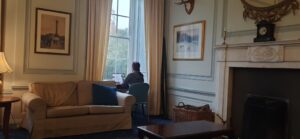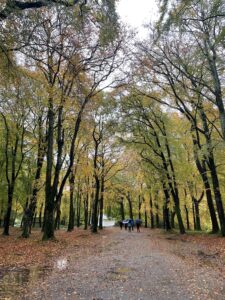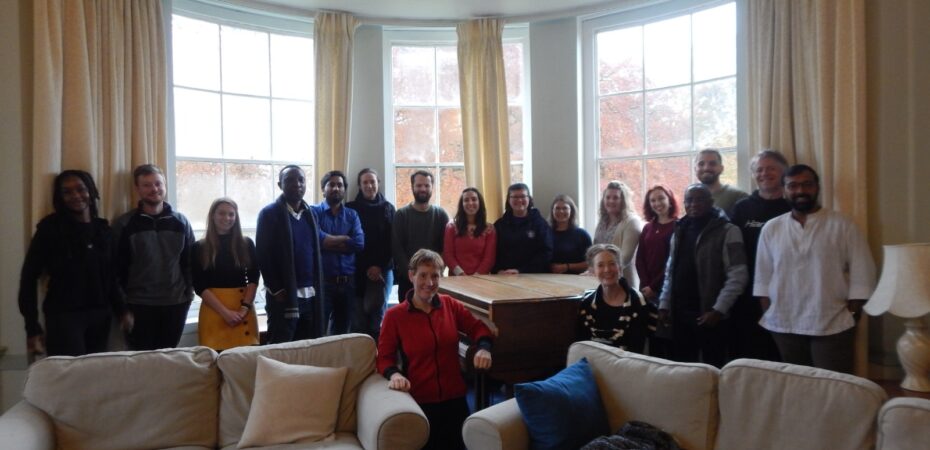Setting the Scene
Imagine a country house with a Drawing Room and a Library, featuring both central heating and a well-functioning fireplace with ample space for over thirty visitors. If you’ve been at the University of Edinburgh for a while, you may well have been a visitor to The Burn yourself. This academic retreat is tucked away amidst 200 acres of woodland with dramatic views of the river North Esk. In other words, the perfect place to unplug – literally and metaphorically – from the hustle and bustle of term time to sit down and get some writing done. (Or, if you are so inclined, imagining Kenneth Branagh turning up with a film crew for the latest remake of Murder, She Said).
I got to spend the last weekend of October facilitating a residential writing retreat for the Institute for Advanced Studies in the Humanities (IASH) at The Burn. The bus took us from central campus out of the city, over the Queensferry Crossing north to this country estate mid-way between Dundee and Aberdeen. Stepping into what felt like another world, we learned about the history of the house from David Turner, the bursar at The Burn, and then quickly settled into our writing after a hearty lunch.
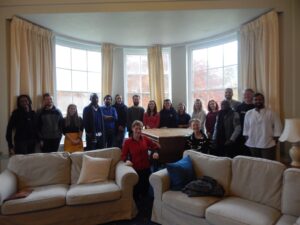
Our Writing Community
Our writing community consisted of 17 IASH fellows and affiliates, and not all of them had met before. We started out with a round of introductions to share our writing goals for the weekend. I gave a warning that ‘I’ll be writing on my book’ won’t do and encouraged the writers to pin down a more specific writing goal. The more precise the goal, the greater the sense of achievement at the end. Among the writing goals for the weekend were the drafting or completion of grant and fellowship applications, rough drafts of book chapters or papers, and the fine-tuning of articles. With clear goals set, we then dispersed for focused time to dive into our writing projects, a brief afternoon coffee break being the only ‘interruption’ to the flow of ideas and words.
The days were very much structured around mealtimes and coffee/tea breaks, allowing us 4 writing blocks for a full day (and 2 writing blocks for a half-day, depending on arrival and departure times). We had one full day on the Saturday, with a group of us embarking on a walk along the river before breakfast. After a brief check-in to revisit (and where necessary adjust) our goals, we wrote on. (I wrote this using the grand piano in the drawing room as my ‘standing desk’.) There’s that palpable motivating energy to writing with others when you are aware of the quiet sound of typing that gives that impression that one can hear thoughts transferred into words.
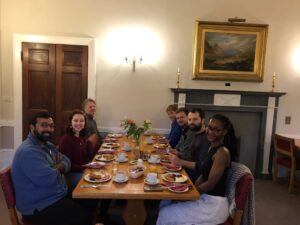
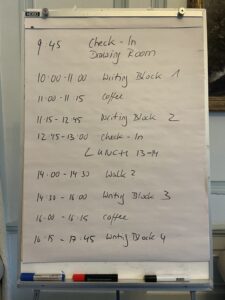
Writing Spaces
There’s something special about working with and tuning in to the environment in which we write. There’s plenty of room in the house to suit everyone’s preferred writing practice. Some settled into the sofas in the Drawing Room with its twentieth-century bay windows that flaunt views of the surrounding trees in their autumn dress; others preferred the more intimate space of the Library, with its desk by the window; others needed a more formal set up with tables and chairs; while a few made good use of the desks in their rooms. Regardless of where in the house we wrote, we all agreed that being away from our usual surrounding is an excellent stimulus for focus, creativity, and inspiration. The social element of the retreat with time for conversations and exchanges about ideas, theories, and methodologies was as important. (There were board games, too!)
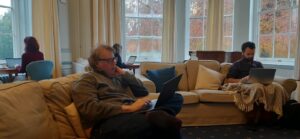
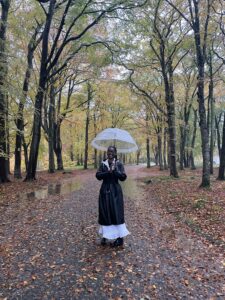
Writing Conversations
Whenever we ‘checked in’ to report on progress and share reflections on the experience of the retreat, many participants were positively surprised that they achieved their specific goals quicker than anticipated and were able to move on to new goals. For many, writing in the same space with others increased motivation and created an accountability that was appreciated. All of us were also conscious of the luxury of not having to think about cooking and household chores. We were extremely well looked after, with fruits and biscuits available all times alongside tea and coffee. (There were even wellies in various sizes and umbrellas that made the rainy walks fun!) Having ‘just’ to think about our writing projects felt rather liberating and resulted in plenty of productivity. We shared our writing challenges – be that about fellowship applications or getting a draft done – which brought on helpful conversations about resources and approaches. Some participants who had similar writing goals set themselves deadlines to exchange drafts.
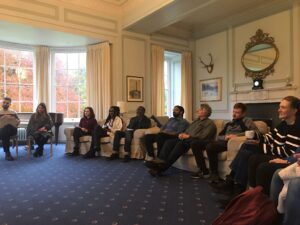
Learnings
Before we departed, I asked the participants to share their learnings and what practice or approach they would like to take with them. Here are the key take-aways:
- Write in different spaces. New environments can bring more focus.
- Set modest goals. Achievable writing goals give a positive feeling of progress.
- Write in short bursts. You don’t always need a full day or a full week to schedule writing; progress can be made in just 90 minutes (or less).
- Schedule writing time. Whether it’s an afternoon, an hour every morning, or a day in the week – writing is part of researchers’ work.
- Use the Pomodoro method for emails. Limit the amount of time spend on emails as they are rarely urgent and the next time you ‘check in’ the issue may have well resolved itself.
We left with new experiences, new connections, and motivation for writing. What a way to launch into Academic Writing Month. Many thanks to IASH and David Turner at The Burn for this fantastic experience!
You can find out more about The Burn here.
Join us for one of our writing hours or writing retreats. Dates and times here.
